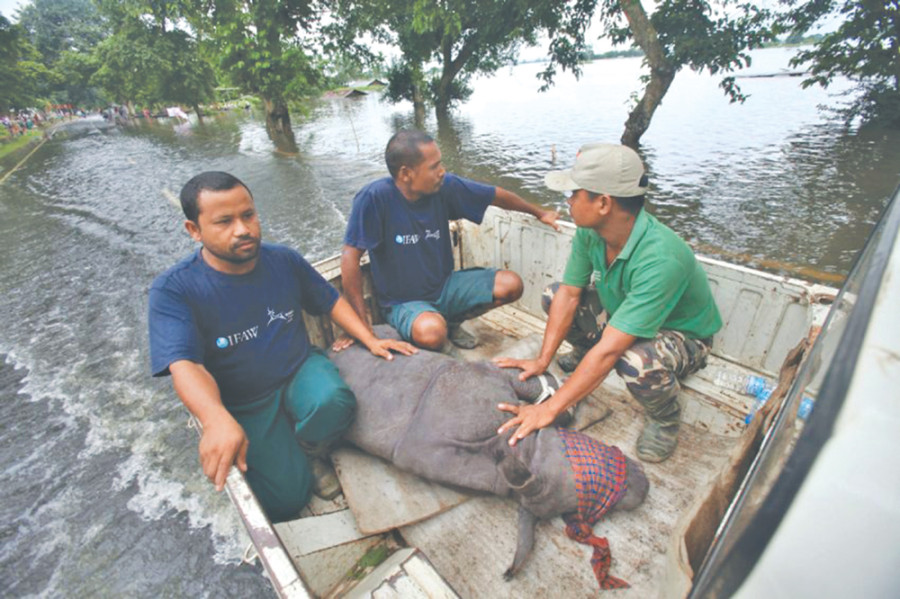Opinion
Woes in the wild
Animals would have so much to say about sufferings from climate change, if only they could
Navin Singh Khadka
Logistically, the annual UN climate conferences are organised quite meticulously. The event venue, usually quite spacious, becomes a self-sustained “town” where thousands of people from across the globe assemble to decide the fate of the planet. And yet, something was missing big time at the meeting venues over the years—until the Paris summit last November. The conference site in the French capital finally had on show what previous hosts of the climate meets seemed to have forgotten: the animals of the planet.
Plastics, glasses and cardboards were cut out into different shapes of animals, mainly flagship species. Although mute, they seemed to be claiming their stakes in the earth’s climate systems. And they kept on reminding the participants that they were suffering equally, if not more, from the impacts of climate change. The lifeless shapes of the animals were enough to press the point that they had to suffer because of the misdeeds by their co-inhabitants, the humans.
Feeding milk to rhinos
If all this sounds like fiction and imagination, fast-forward to the present and see what is happening to animals because of extreme weather events in our own region. Nearly 250 wild animals died in the Kaziranga National Park in India’s Assam state this month because of floods. Nearly 20 rhinos, most of them calves, 185 hog deer, some wild buffaloes and boars, among others, were killed by flood waters. Pictures on social media showed that many of these animals from the Unesco natural heritage site came out to highways and human settlements to escape the disaster.
Conservationists were worried that poachers would now easily get what they were looking for, including rhino horns and body parts of tigers. It was indeed a very worrying situation. Floods from the swelled Bramhaputra river had submerged nearly 90 percent of the Kaziranga National Park. No wonder the animals were desperate to get out. In the aftermath, pictures showing people feeding milk to rhino calves went viral. There were reports that communities were willing to adopt many of the orphaned pachyderms.
The floods may have receded now but that is not the end of the miseries for the animals. A huge quantity of sand has been dumped in many areas of the state. Media have reported that the worst hit places now look like deserts. The wild animals in the Kaziranga National Park must have been left perplexed how the green vegetation had all of a sudden turned barren.
A wild elephant from the region was not as lucky to get to see its habitat again. Strong river currents swept it more than 1,000 miles downstream. When it regained some balance to stand up on its own, it had reached a different country—Bangladesh. According to media reports, it wanted to climb ashore but was driven back to water by villagers at many locations. After weeks of struggle, it finally received some medical help from veterinary personnel, but it was too late. The nine-foot, four-tonne male finally fell in a muddy field before taking his last breath.
It is not only about floods creating life and death situation for wild animals. Temperature rise too has caused problems for wildlife. A few weeks ago, Indian media reported that a Royal Bengal tiger was spotted at an altitude of 12,000 feet in Uttarakhand. This is the height where you normally find snow leopards while tigers roam at places between 3,000 and 4,000 feet above sea level. “It’s not healthy news,” New Delhi Times quoted DP Dobhal of Dehradun-based Wadia Institute of Himalayan Geology. “The animal found it warm at an elevation of 12,000 feet. Now, more animals may scale up and that will pose threats to other animals of upper Himalayas.”
Further north in Kashmir, there have been reports of increasing incidents of conflict between Asian black bears and humans. Scientists and officials say warmer winters have led to a decreased hibernation period for the bears and, as a result, the animals come in contact with people more frequently. Wildlife department figures show that 40 people were killed and 562 injured by black bears in Kashmir between 2011 and 2012.
No follow-up study
If this is what climate change-induced extreme weather has done to the wildlife in our neighbourhood, the story with those in Nepali territory is certainly not going to be different. And you may be wondering why this write-up chose to talk about Indian wildlife then. The trouble is climatic impacts on Nepali wildlife have hardly been studied and documented. When wildfire engulfed the Bardiya national park in 2012, government officials estimated that 40 percent of small mammals, 60 percent of insects and a significant number of birds had been lost. I reported that for the BBC then. But there was no follow-up study after the event.
The Intergovernmental Panel on Climate Change, the UN climate science body, has warned of increasing pressures on wildlife because of climatic changes. “Laboratory and field studies have demonstrated that climate plays a strong role in limiting species’ ranges,” it said in its assessment.
True that people’s sufferings because of extreme weather events overshadow the impacts on wildlife. But wild animals are inextricably linked to the natural ecosystem we depend on. If they are disturbed, that will have a knock-on effect on us. For instance, if elephants’ habitats are hit by extreme weather events, they will come out and that may cause severe damages to human settlements and farmlands.
That is exactly why climate plans these days include programmes to help wildlife and their habitats. One of the five components of the World Bank’s Strategic Programme on Climate Resilience is “Enhancing climate resilience of endangered species” and it was launched for a genuine cause. How far has it moved ahead, if at all, is a different matter altogether.
As Nepal continues to be lashed at by heavy rainfall, do remember that it is not just us who suffer. There is a wild world out there that gets wet too.
Khadka is a BBC journalist based in London




 18.12°C Kathmandu
18.12°C Kathmandu










